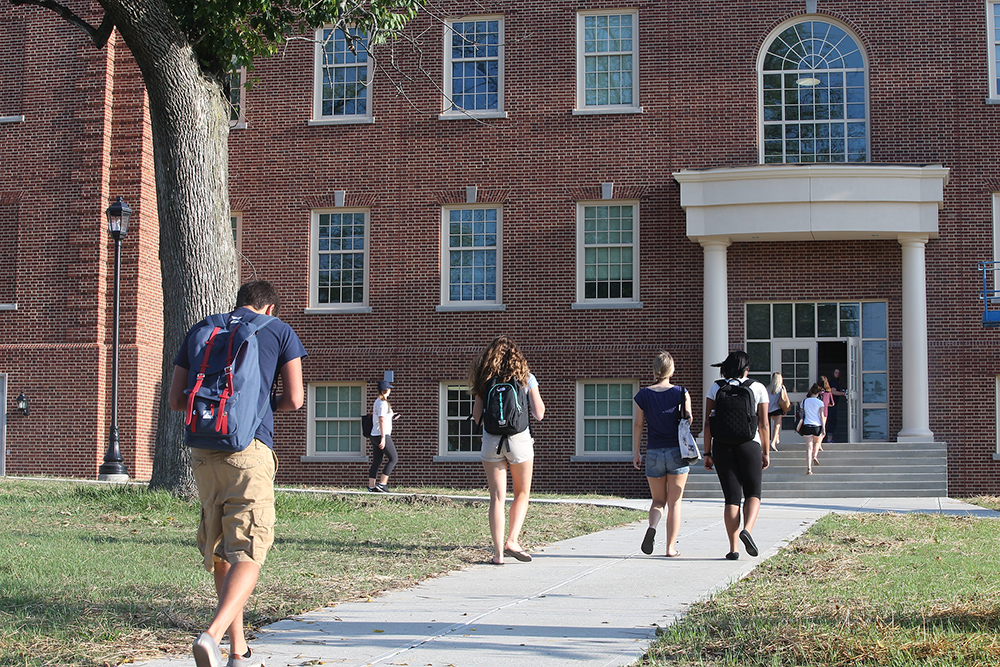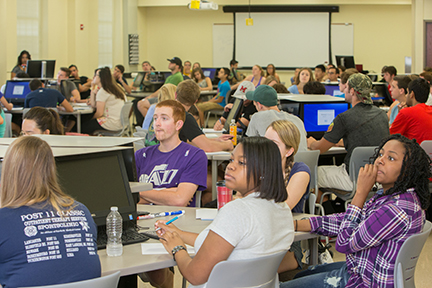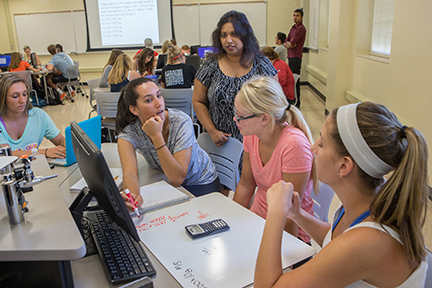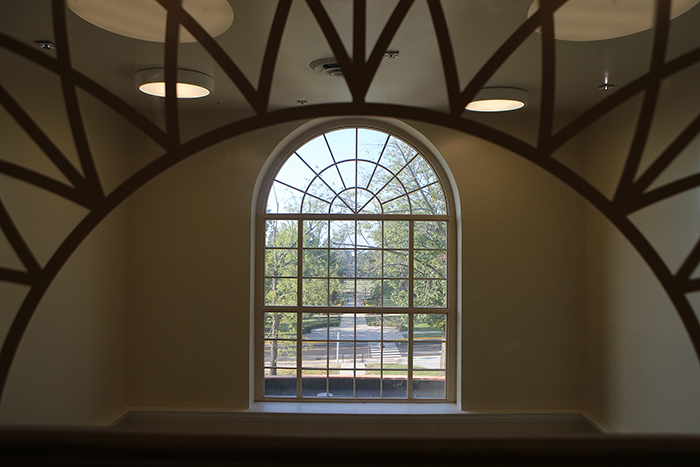

Physics department introduces new SCALE-UP teaching approach
Written by Margo Kissell, university news and communications, kisselm@MiamiOH.edu
The department of physics has introduced a new approach to teaching 100-level physics classes that encourages students to work together in groups to solve problems in class.
The method known as SCALE-UP (Student-Centered Activities for Large-Enrollment Undergraduate Programs) integrates lab and lecture into a studio environment.

Students taking 100-level physics classes this semester will work collaboratively on laboratory activities, computer modeling and paper-and-pencil problem solving. Those activities are interspersed with short lectures (photo by Scott Kissell).
The department recently moved from Culler Hall into Kreger Hall, which was completely renovated. New instructional classrooms were designed with the SCALE-UP model in mind.
"SCALE-UP is an approach where students work collaboratively together in groups and are way more active than just sitting in a lecture hall," said Herbert Jaeger, chairman of the department of physics.
The new approach will only be used in introductory calculus-based and algebra-based classes, Jaeger said. He noted research indicates the approach leads to better retention and "students have more fun, which is not something they realize they could have in physics class."
Students are in class about the same amount of time as before but that time is organized differently, said Jennifer Blue, associate professor of physics.
Students spend less time sitting in lectures and more time working together in class. The onus is put on them to do required reading on their own outside the classroom.
It is a flipped approach from last year when students spent more time in lectures and then tried to solve problems on their own after class, sometimes struggling.

Dilupama Divaratne, visiting assistant professor of physics, uses the SCALE-UP approach in the College Physics (PHY 171/173) course (photo by Scott Kissell).
In the studio environment, "students are seated at tables of nine in groups of three, and this can be 'scaled up' to a class of 99 with little difficulty," Blue said.
Each group has a computer and work can be projected from any computer in the room to one of several white boards. The students work collaboratively on laboratory activities, computer modeling and paper-and-pencil problem solving. Those activities are interspersed with short lectures.
"Students are active, they see immediate applications of what they learn, and they get to do something new every 15 minutes," Blue said.
The department used two, $3,000 grants from Miami's Center for the Enhancement of Learning, Teaching and University Assessment (CELTUA) to learn more about implementing SCALE-UP.
Four faculty members visited SCALE-UP classrooms at North Carolina State University and the University of North Carolina last fall. That was followed by a two-day, on-campus workshop held for faculty and teaching assistants this summer.
Blue said the department has been preparing for this change for years. Culler classrooms were not conducive to the SCALE-UP approach because it requires a flat room, not an auditorium, with enough room for a large class, she said.
Kreger Hall offers two studio-type spaces for SCALE-UP instruction, one seating 72 students and the other seating 99.
The instructor and graduate student TAs roam the room answering questions and providing guidance.
"They are generally supportive of what is going on rather than being in front, the source of information," said Jon Gaffney, assistant professor of physics at Eastern Kentucky University who led this summer's training workshop.

The view through Kreger Hall's front window (photo by Jeff Sabo).
Gaffney said SCALE-UP has been around for at least 15 years and research shows it leads to improved conceptual learning and problem-solving ability.
"Students tend to like the class more after they get used to it," he said.
Blue noted SCALE-UP is similar to CELTUA's "Top 25 Project: Engaging Students in their Learning," which President David Hodge launched in 2006.
The department of physics didn't qualify for that project due to enrollment numbers at that time, but can now implement a similar approach through SCALE-UP, a model CELTUA supports.
Said Jaeger: "The whole gist is to make the class more active."
